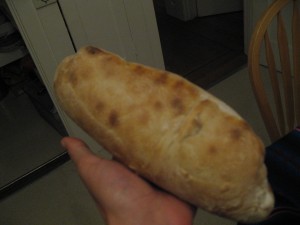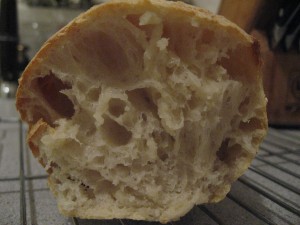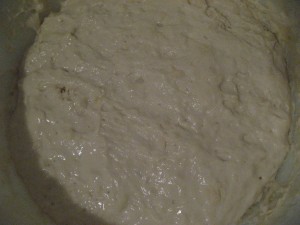I recently switched from Mello Judith to Power Flour, and I am really noticing a difference. I started the 50lb sack of flour with a sourdough loaf that was at 65% hydration, but much easier to handle and way less sticky than I was used to. The loaves (1 baguette and 2 boules) ended up barely rising over night, so in the morning I put one of them outside in the warm weather. I came back at 3PM and the one outside had risen just a bit more, but was really dried out. Regardless, they all baked about the same in the oven. The crust was nice and crisp, although still not quite as crispy as I’d like. Also, the flavor was real savory. I believe it partially has to do with the long undesturbed proof time (around 18 hours). It also might be that I just prefer the taste of the Power Flour to the Mello Judith. I will have to taste quite a few more breads before I can attribute it to that though.
I imagine that if the dough had risen more, I would have gotten a nice tighter surface, which would have crisped the crust more. I believe that since the Power Flour was stronger and the gluten more developed than I am used to, the starter needed to be much more active, or a larger percentage of the entire dough (I had a 4X Blarf factor, but might want closer to 3X or lower).
So I decided to go back to a 3:3:2 sponge that I had been doing quite a bit of about a week ago. I mixed 300g 48hour 2:1:1 Dulce with 300g Power Flour and 200g water. Half hour later or so I gave it a turn, and saw that it was already developing quite well. I kept turning it every once in a while (2 or 3 turns at a time sometimes) for about 2 hours, and then decided that it was developed enough to shape into ciabatta. But I had forgotten to add salt, so I added some, and turned it quite a few more times to mix it together. I split the dough in half and shaped them around 9:00PM. I was going to split 1 of the 400g ciabattas into 2 smaller ones, but I decided to just keep it at 2. By 12:00AM they seemed quite puffy, so I decided to bake one.
As I tried to roll the ciabatta from the canvas, I saw that I was sticking from under flouring. Because the dough was so wet, it needed a ton of flour. I had put a few handfuls and rubbed it in, and then sprinkled some extra, but apparently that was not enough. Luckily I was able to get most of it off, and onto the peel in good shape. I threw it in the 550F oven along with a non heated (which is somewhat new for me) cast iron pan filled with half a cup of water. I checked on it 5 minutes later, and it had puffed up a ton, and was starting to have a few brown spots, but still not caramelized all over. I flipped it around, and the steam had all evaporated by then. I also turned the oven down to 500 because I was beginning to worry about burning the loaf before it cooked fully. I checked again in 4 minutes, but it wasn’t quite done; finally after 13 total minutes, I took it out. The crust wasn’t fully browned, but it was hollow sounding when knocked on the bottom, and the thermometer read 206F in the bread, which is in the range that most people say to bake it to (200-210?).
It got more oven spring that I am used to. I think that is because it was so hydrated, yet still had well developed glutten. Combine that with a starter that is just starting to peak on its food cycle (about 4 hours after getting a heavy dose of flour). I also had a tear in the bottom of the bread, which is new for me. I think its because of when I ripped it off the canvas, and that piece ended up being underneath the shaped loaf when I rolled it. The loaf felt a bit dense, but that was to be expected after such a short (3 hour) total ferment time. The crust seems pretty crispy right after baking, but still looks like it could use a bit more crispiness to my liking. I think that might happen with a less hydrated dough, and one that has a bit more time to proof out from its shape.
It as late, and I got tired of waiting for it to cool down properly, so I waited only 10 minutes before diving in. It was still doughy, as it didn’t get time to finish baking during the cooling phase. But it had gotten some fairly nice holes, especially considering it only fermented for 2 hours and proofed for 1. The taste was lacking severely, which was not too surprising considering the high Blarf factor (low percentage of overall dough) combined with very short total ferment time. The crust was decently crispy as it seemed, but not flaking enough. Overall decent bread, but the biggest concern was definitely lack of flavor versus structural issues. So any bread I decide to be making quickly needs to have a low Blarf factor (as Blarf already has the flour developing flavor for many, many hours prior to its use).



I have left behind one of the ciabatta loaves to rise in the morning. I expect that the 11 hours or so will probably be overproofing for it, but because it is so hydrated, it might spring back up in the oven if it does deflate. I also expect a bit of stick, even though I rolled it onto a different spot of the canvas with even more flour. But the flavor should be much better, and I should have a fluffier crumb.
I’ve also started another 3:2:2 sponge that tomorrow I am going to add more flour to and make some sourdough baguettes and boules.

